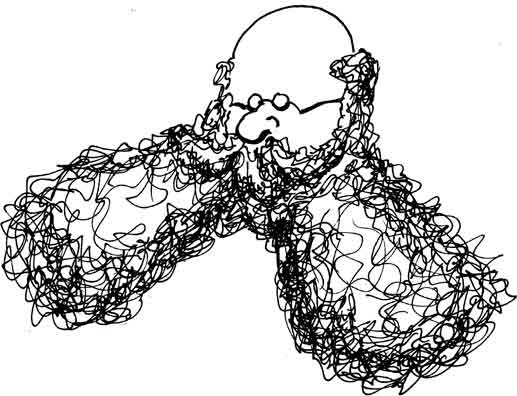Edward Lear

Edward Lear
There once was a day and a time
When poems were superb and sublime.
Then things got much worse
And today's fancy verse,
Has neither meter nor rhyme.
In fact, you'll find some poetry magazines - or at least when there were such things as magazines - that stated in their guidelines:
WE DO NOT ACCEPT RHYMED POETRY!
... which is kind of like the College of Cardinals not accepting a Catholic Pope. But for some reasons as the years rolled on poets felt that rhymes somehow detracted from the art.
And for modern poets, a path to success is assured.
|
A poet's a scribe, not a creditor, Who has patience and guile like a predator. For success - we're not foolin'- Your poem is a shoo-in, If you went to school with the editor. |
And a brief perusal of modern poems makes it clear why poetry books generally don't sell to the masses.
The exception, of course, is the limerick. This form of poetry - yes, poetry as honorable as a Shakespearean sonnet - has a strict rhyme which English teachers say is AABBA. The meter is called anapestic trimeter. This is represented by eggheads as:
˘ ˘ -
Or as the hoi polloi would put it;
da da DA
The total metric of a limerick is then that the first two lines have three anapestic trimeters. These lines are followed by two more lines of two anapestic trimeters. Then the final line is again three anapestic trimeters.
That is, you get:
|
da da DA da da DA da da DA da da DA da da DA da da DA da da DA da da DA da da DA da da DA da da DA da da DA da da DA |
Or for the eggheads:
|
˘ ˘ - ˘ ˘ - ˘ ˘ - ˘ ˘ - ˘ ˘ - ˘ ˘ - ˘ ˘ - ˘ ˘ - ˘ ˘ - ˘ ˘ - ˘ ˘ - ˘ ˘ - ˘ ˘ - |
As in all poetry you can modify the meter to fit specific words. That is you can use pauses or slip in extra syllables as long as the basic meter is maintained.
In addition to us being told that - quote - "good poetry" - unquote - should have no rhyme, we also hear that when you read poetry you should make sure you ignore the meter! Such an absurdity of this statement needs no elaboration.
Alas, Edward Lear did not invent the limerick and in fact didn't even invent the good limerick. Certainly by today's standards his poems in his 1846 A Book of Nonsense seem lame if not completely pointless.
|
There was an Old Person of Chili, Whose conduct was painful and silly, He sat on the stairs, Eating apples and pears, That imprudent Old Person of Chili. |
Today people wonder why Edward wasted his last line by more or less repeating the first. But Edward did not intend his poems to be actual jokes. Almost all jokes set up a scene where the listener expects something to happen but the actual outcome is something else. This sudden shift of the point of view is what makes us laugh. So with a minor modification of Edward's nonsense poems, we got the modern limerick.
|
Once a young man from Dareeling, Boarded a bus bound for Ealing. Read a sign on the door "Do not spit on the floor." So he jumped up and spat on the ceiling. |
Short and intentionally humorous verse is not a modern phenomenon. The epigram was popular in the ancient world and the most famous epigrammatisist was the Roman poet, Marcus Valerius Martialis. Better known by the Anglicized name of Martial, his verse ran from fairly lengthy poems to two line couplets.
|
Nuper erat medicus, nunc est vespillo, Diaulus. Quod vespillo fecit, fecerat et medicus. |
... which can be translated literally if not poetically:
Diaulus was recently a doctor, now he is an undertaker.
What the undertaker does, the doctor also did.

Martial
You'll notice that the original Latin can be read in a fairly bouncy meter (although there was no rhyme). But in both Latin and Greek poetry the meter was not based on accent but on the syllable length. But for a heavily stressed language like English, the meter of poetry is determined by accent.
How a particular English verse form got labeled with the name of a town in Ireland is (and will remain) a mystery. You can find plenty of speculation (and spook etymologies) on the Fount of All Knowledge. But we emphasize no one really knows.
Although beginning in the latter 20th century the limerick has gotten some boost in prestige, it is still not something you find in high brow anthologies. But it was recognized as - and we quote - "the most popular form of verse in English" - as early as 1918. Even at that early and delicate date, it was acknowledged that there was a certain - ah - reputation for the Limerick.
There was a young lady of Chichester,
Who made all the saints in their niches stir.
And one day during matins,
Her shape in white satins,
Made the Bishop of Chichester's britches stir.
Sadly, some of the writers who are masters of one genre fail at the exacting task of writing the limerick. Although Isaac Asimov and John Ciardi traded limericks in a jointly published volume and Issac published his own book, there's really not much doubt that this literary form was neither's métier.
So in the end about all we can say is:
|
A limerick packs laugh anatomical, Into a space quite economical. But the good ones we've seen, So seldom are clean, And the clean ones so seldom are comical. |
References
The Penguin Book of Limericks, E. O. Parrott, Viking, 1983
"The Cult of the Limerick", The Living Age, Volume 296, The Living Age Company, 1918.
A Grossery Of Limericks, Isaac Asimov and John Ciardi, W. W. Norton & Company, 1981.
Lecherous Limericks, Isaac Asimov, Walker, 1975